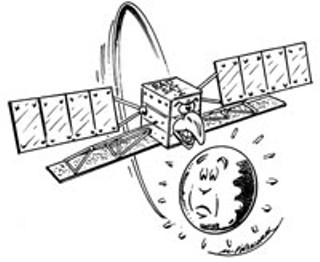The veteran peace activist Richard Sanders calls it “The War Fighters’ Eye in the Sky.” The eye in question is a sophisticated Canadian satellite called RADARSAT-1. It’s capable of peering through clouds and darkness to produce detailed images of the earth’s surface. “RADARSAT is, in fact, a major Canadian contribution to US-led wars that have killed tens of thousands of innocent civilians,” Sanders writes in the latest issue of a magazine published by COAT, the Coalition to Oppose the Arms Trade. He notes that few Canadians realize that a billion dollars in tax money has been spent so far on RADARSAT, making Canada a leader in the militarization of space.
RADARSAT-1 was launched by NASA in 1995. Back then, a NASA news release painted a glowing picture of a Canadian satellite that could monitor Arctic ice conditions to ensure the safety of ships. NASA announced that from its orbit nearly 500 miles high, the satellite could also measure the size of oil spills to aid in cleanup efforts. “Many of the world’s rain forest areas, mountainous and coastal regions will be accurately mapped for the first time,” the news release added. “By mapping the Earth’s surface using radar, geological features can be used in the search for new mineral, oil and gas deposits.” On and on the glowing list went, but the news release failed to mention RADARSAT’s military uses. A good thing, too, since Canadian politicians had already said the satellite would not be used for military purposes. The NASA news release did point out, though, that in return for launching the satellite, “US government agencies will have access to all six-month-old archived RADARSAT data and direct approximately 15 percent of the satellite’s observing time.”
Sanders writes that since the satellite started operating in April 1996, the US Navy, Air Force, Army and various American intelligence agencies have purchased millions of dollars worth of additional RADARSAT data and observing time. For example, the US uses images from RADARSAT and other spy satellites to help fight its wars in Iraq and Afghanistan. In 2003, the US military bought RADARSAT images of more than 50 percent of the world’s surface to help in what was described as logistics and planning. Two years earlier, the Americans purchased a detailed 3-D terrain map covering the entire South American country of Colombia.
Although the Canadian government owns RADARSAT-1, the Liberals decided last year to privatize a sister satellite scheduled to be launched this December. MDA Corporation of Richmond, BC, will own and operate RADARSAT-2, but Canadian taxpayers are contributing most of the money to finance it—more than $400 million. The Canadian Space Agency describes RADARSAT-2 as “the most advanced satellite of its kind in the world.” In its 2005 annual report however, the agency doesn’t mention the satellite’s military uses. “RADARSAT-2 will continue to provide all-weather, day-and-night coverage of the entire globe to support fishing, shipping, oil and gas exploration, offshore drilling, mapping and ocean research,” it reports. But a 2004 news release from MDA Corporation makes it clear that the US plans to use RADARSAT-2 to continue providing what the company calls “in-theatre support for the war fighter.” The satellite will also be carrying experimental sensors to enable the US military to detect and track moving vehicles on the earth’s surface.
For the last five years, MDA and the government have been laying ambitious plans for a third satellite to operate in tandem with RADARSAT-2. An MDA news release says that if everything goes according to plan, the two satellites would create detailed maps of the earth’s entire surface. “This would represent the most advanced space-borne land information and mapping mission ever conceived,” the company says. It would also help Canada’s dear friend, Uncle Sam, pursue his imperial ambitions—all thanks to generous support from the good old—but unsuspecting—Canadian taxpayer.
How should we direct our eyes in the skies? Launch your comments to: [email protected]















